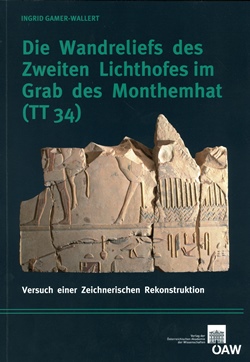Monthemhat, „Auge und Ohr seines Herrschers“ in den Jahrzehnten des Übergangs von der 25. zur 26. Dynastie, konnte, wie er selbst versicherte, bei der Errichtung seines Grabes die Besten „aus der für den Palast bestimmten Arbeiterschaft“ auswählen. Entsprechend hoch war die Qualität der 57 dekorierten Räume seines sich über drei Ebenen erhebenden Grabmonuments (TT 34) im Asasif von Theben. Im Besonderen galt dies für den über 12 m langen und 16 m breiten Zweiten Lichthof. An seinen Wänden entfalteten sich in erhabenem und farbig gefasstem Relief die lebhaftesten Bilder aus dem Alltag des Grabherrn. Heute ist von jener Pracht etwa ein Fünftel in situ erhalten. Das Übrige liegt, in kleinste Fragmente zersplittert, am Boden, verstreut über das ganze Grab, vieles geraubt und verkauft.
In diesem Band wird der erste Versuch einer zeichnerischen Rekonstruktion des Wandschmucks gemacht. Hilfe bietet dabei eine für jene Zeit typische, archaisierende Tendenz in der Kunst, die sich an vergleichbaren Inhalten der Grabwände des Alten Reiches orientierte. Teilweise helfen auch Vergleichsmöglichkeiten in dem nahe gelegenen Grab des Ibi (TT 36). Vor unseren Augen entsteht ein lebendiges Bild von Monthemhats Reichtum, Ergebnis einer emsig in Garten und Feld, am Wasser und auf der Weide arbeitenden Dienerschaft. Wir erleben die Rückkehr der reich beladenen Lastschiffe aus dem Süden, die Tätigkeiten der Goldschmiede, Bildhauer, Schiffsbauer, Wagner, die Herstellung der Sandalen, Kanopen und Uschebtis in den Werkstätten des Grabherrn „innen und außen“. Wir nehmen Teil an seinen Vergnügungen bei Brettspiel, Musik und Tanz, begleiten die Winzer, Feldarbeiter, Hirten, Fischer und Vogelfänger, aber auch den Grabherrn bei der Vogel- und Fischjagd mit dem Wurfholz oder dem Speer in den belebten Papyrussümpfen.
Zweifellos ein Höhepunkt der ägyptischen Flachbildkunst der ersten Hälfte des 7. Jahrhunderts v. Chr.
Monthemhat, “eye and ear of his Majesty” in the decades of transition from the 25th to the 26th dynasty, was able, as he assures us, to select the best of the palace workmen for himself. The decoration of his funeral monument (TT 34), extending over three levels in the Asasif of Thebes, was accordingly of the highest quality. This applies especially to the so-called Second Courtyard. Its walls, 12 m long and 16 m wide, were covered with scenes of daily life and the surroundings of the tomb owner and his family, depicted in elevated and richly painted relief. Today only one fifth of this splendour is conserved in situ, with hundreds of tiny broken fragments lying on the ground, others scattered all over the tomb; many fragments were robbed and sold abroad.
This volume is the first attempt to reconstruct the design of this wall decoration. The archaistic tendency in the art of this period, orienting itself by comparable contents of Old Kingdom tombs, helped us here, as did also the possibilities of comparison with the nearby tomb of Ibi (TT 36). Before our eyes there arises a vivid panorama of Monthemhat’s wealth, the product of his domestics, who are working industriously in garden and field, beside the water or in the pasture. We observe the return of the heavily loaded ships coming from the South, the activities of gold-smiths, sculptors, ship-builders, carriage-builders, and the production of sandals, canopic jars and ushebtis in the workshops of the tomb-owner. Finally, we participate in his recreational activities, such as board games, music and dance, also in the hunting of bird and fish by the throw-stick or the spear in the animated papyrus-marshes.



 Home
Home
 Print
Print
 References
References
 Share
Share